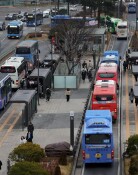Inter-Korean Rail Project Proceeds Despite Tension
Inter-Korean Rail Project Proceeds Despite Tension
Posted February. 19, 2009 08:17,
Trains wish to run (to North Korea).
This is what a signboard read to mark the end of an inter-Korean railway at Shintan-ri Rail Station in Yeoncheon County, Gyeonggi Province.
While inter-Korean tension has heightened in recent weeks, construction work continues around the station to reconnect Gyeongwon Railway, which symbolizes the dream of a reunified Korea.
Workers were busy at work to lay the railway bed to increase the level of land 10 meters above normal, with a sign warning of landmines. In a tunnel, the centerpiece of the project for reconnecting the inter-Korean railway, heavy duty equipment broke off layers of rock amid a roaring sound with its two arms stretched out.
In 1914, the rail line was opened to link Yongsan Rail Station in Seoul to Wonsan, South Hamkyong Province (present-day North Korea). The railway, however, was cut off at Shintan-ri Station in the South immediately after the 1953 armistice was signed.
Signs of tracks in the northern section of the railway have disappeared.
The reconnection project began in September last year, 55 years after the line was severed. A 5.6-kilometer section beginning from Shintan-ri Station will be connected to Daema-ri in Cheorwon, Gangwon Province.
Less than one kilometer separates Daema-ri to the Southern Limit Line that restricts civilian access, while the Demilitarized Zone is just five kilometers away.
Though the section is relatively short, the project is much tougher here than on a regular land surface since it entails the construction of three tunnels and 18 bridges. Thirteen percent of the project has been completed.
Yuri No. 1 Tunnel (455 meters) was excavated 200 meters in taking shape as a tunnel. Following this section, the only broken bridge in its original shape on the entire Gyeongui Line was spotted.
A triangular sign warning of landmines was also seen at a location near the construction site. During the projects implementation, four anti-military tank and three landmines and one highly explosive bomb were unearthed.
Kim Yeong-joon, site supervisor with Yojin Construction and Engineering, which is conducting the project, said, Weve been always highly vigilant since explosives are often discovered in construction as if to show intense battles between South and North Korea during the war.
Workers also could not choose the shortest cut or had to raise the land level in this section due to the presence of a key military unit stationed there.
Going beyond the line restricting civilian access after the construction section, a section of the Mount Kumgang railway line was linked to the Gyeongwon Line. Until the Korean War, travelers heading to the scenic mountain had to transfer from the Gyeongwon to the Mount Kumkang line at Cheorwon Station.
A tourism road is linked to Mount Kumkang. Sources at the construction company said that if the Mount Kumkang line is reopened, inter-Korean relations will improve in addition to more tourists crossing the border.
The areas surrounding the line, however, are strategically important for the militaries of both Koreas. Hence, reconnection of the line crossing the sections will prove difficult for the time being.
The section where the line is being reconnected is an area with a small population and low freight volume. So whether trains will run even after the projects completion late next year is in doubt. The railway is being reconnected, however, as a project preparing for an era of reunification rather than a business venture needing viability.
When the project is completed, the signboard reading, Trains hope to run (to North Korea) will be moved further north in a sign of getting closer to reunification.
Site supervisor Kim said he has only one hope. I really would like to see South and North Korea join forces to reconnect the Gyeongwon Line as soon as possible, and link the line to North Koreas railway network, and then to the Trans-Siberian Railway to cross the Eurasian continent.
argus@donga.com







